The 66-hour battle between Israel and the Palestinian Islamic Jihad terror group, dubbed Operation Breaking Dawn, that ended with a ceasefire Sunday night was touted by officials as one of the most successful rounds of fighting in the Gaza Strip. But it won’t be the last.
The Israel Defense Forces initially faced criticism over preemptive measures it took during the three days leading up to the operation.
Saying there were indications of an imminent PIJ attack against civilians or soldiers on the border, the army effectively locked thousands of residents in their homes as it shut roads and train lines that were vulnerable to fire from Gaza. Opposition lawmakers railed at the military’s decision, saying the terror group had won without even firing a single shot.
But by the end of the fighting, with a ceasefire agreed upon, senior terror commanders killed, minimal injuries on the Israeli side, and record-breaking Iron Dome air defense system interception rates, the mood had changed. Still, the army acknowledged it had not reached all of its goals, indicating that fighting with the terror group would eventually have to resume.
While the violence lasted just under three days, escalatory moves began a week earlier. With the IDF ramping up arrest operations in the northern West Bank against PIJ members and other armed Palestinians, the Military Intelligence Directorate had indications the Gaza-based terror group would attempt to launch an attack on the border. The indications grew stronger after the arrest of Bassem Saadi, the PIJ’s West Bank leader.
Get The Times of Israel's Daily Edition by email and never miss our top stories
Saadi’s detention last Monday prompted the widespread closures along the border with the Gaza Strip. Military officials said there was “concrete” information of an “imminent” attack. The closures would last several days, as the IDF deployed thousands of troops to the area and readied the Iron Dome missile defense system in the south, Tel Aviv, and Jerusalem.
Shortly after noon on Friday, after a lengthy meeting with Prime Minister Yair Lapid and top military officials, Defense Minister Benny Gantz told reporters the PIJ threat would be removed “one way or another.”
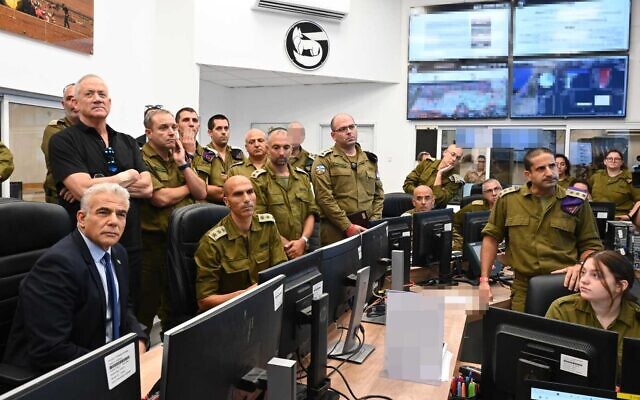
Prime Minister Yair Lapid (L) and Defense Minister Benny Gantz (2nd-L) tour the IDF’s Southern Command on August 7, 2022, amid fighting in the Gaza Strip between Israel and the Palestinian Islamic Jihad terror group. (Haim Zach/GPO)
The decision had already been made.
At 4:16 p.m., the Israeli Air Force targeted an apartment in a 14-story building, killing Tayseer Jabari, the PIJ’s commander for northern Gaza. In separate airstrikes, several terror squads en route to commit an attack were also attacked, according to military officials. The entire opening operation lasted just 170 seconds.
The army continued to take out PIJ sites across the Strip, and the terror group began launching rockets at Israel in response several hours later.
The IDF said in total over the three days, more than 1,100 rockets and mortars were launched from the Gaza Strip at Israel. The Iron Dome intercepted some 380 projectiles fired toward populated areas, at an unprecedented 96 percent success rate. The high interception rate was attributed to upgrades to the defense system, as well as PIJ’s limited firepower.
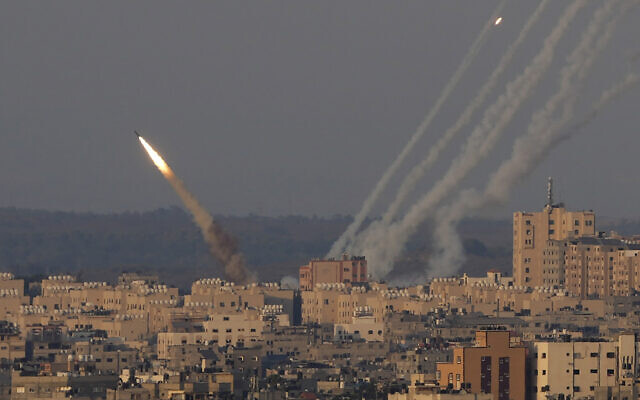
Rockets are launched from the Gaza Strip towards Israel, in Gaza City, August 7, 2022. (AP Photo/Hatem Moussa, File)
While the PIJ is believed to have thousands of projectiles, the vast majority of them are thought to be short-range rockets or mortars, according to military assessments. The terror group has some long-range rockets, but not close to the capacity that the Hamas terror group has, which managed to attack central Israel repeatedly during a war in May 2021. At the same time, upgrades to the Iron Dome’s Tamir missiles have raised the successful interception rate.
However, there were several rockets that managed to evade the system and land in populated areas, causing some damage to homes and civilian infrastructure, as well as slightly injuring at least four people including two soldiers. Military officials praised the Air Force unit that operates the Iron Dome for managing to prevent major casualties.
Also according to the IDF’s data, some 200 rockets launched toward Israel fell short in the Gaza Strip. In several cases, failed rocket launches killed Palestinian civilians. According to military estimates, at least 16 uninvolved Palestinians were killed in such incidents, some of them children.
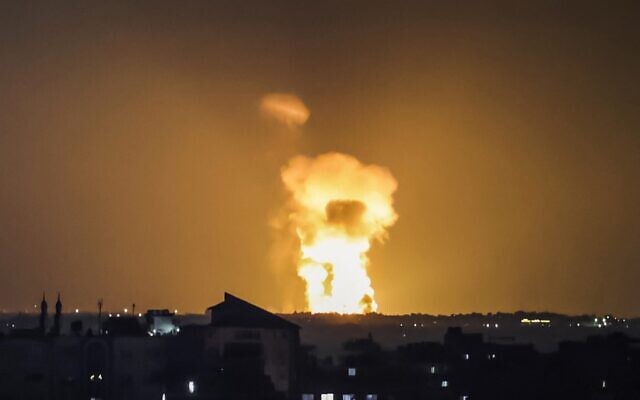
A fireball rises from the site of an Israeli airstrike in Khan Yunis in the southern Gaza Strip on August 7, 2022 shortly before a ceasefire took effect. (MOHAMMED ABED/AFP)
In all, the IDF said it struck over 170 PIJ targets across the strip, including weapon caches, observation posts, and rocket launching sites. A major airstrike on the second night of the operation killed Jabari’s southern counterpart, Khaled Mansour.
Military officials said the targeted killings of senior PIJ members had crippled its chain of command, a major achievement for Israel in the round of fighting. But it did not prevent the continuation of rocket fire until just after the ceasefire.
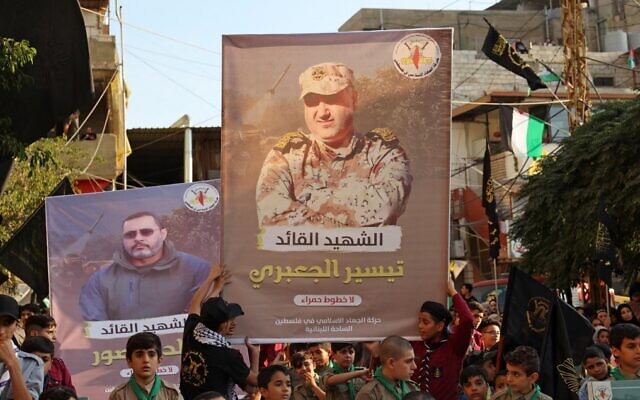
Supporters of the Palestinian Islamic Jihad terror group march with posters depicting senior commanders Khaled Mansour (L) and Tayseer Jabari, who were killed in Israeli strikes on the Gaza Strip, during a rally in Lebanon’s refugee camp of Burj al-Barajneh on August 7, 2022. (Anwar Amro/AFP)
The IDF struggled to actively prevent rocket fire on Israel, with officials saying that it had struck 10 squads who were en route to launching an attack or had just fired rockets. And meanwhile, officials acknowledged that while the IDF struck several PIJ rocket warehouses, causing “significant damage” to its abilities, it was “not absolute,” and the terror group still has thousands of rockets ready to fire in the next round of fighting.
Military officials also said that it did not manage to significantly harm the terror group’s infrastructure. Had the fighting continued, they said, the military “would have reached this goal as well.”
The IDF said it would investigate the deaths of at least 11 uninvolved civilians it killed in its airstrikes. This included Mansour’s wife and the wife of another PIJ commander, who were in an apartment in southern Gaza during the major airstrike.
The Hamas-run health ministry in the Gaza Strip said 44 people were killed amid the fighting, including 15 children, but it did not say how many of the total killed were affiliated with terror groups. At least 15 deaths were claimed as members by the PIJ, Hamas and another, smaller, terror group.
Israel generally rejects criticism that it targets civilians, saying it takes numerous precautions to prevent such unnecessary casualties.
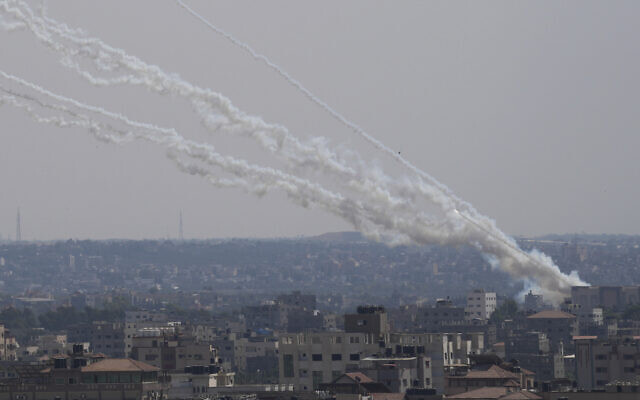
Rockets are launched from the Gaza Strip towards Israel, in Gaza City, August 7, 2022. (AP Photo/Hatem Moussa)
It says its target selection is based on sophisticated intelligence and is cleared by legal advisers and other experts, and that it often warns inhabitants to evacuate before their homes are struck. The military also says it has fine-tuned its guided missiles, delivering small payloads that minimize damage beyond the precise target.
Israel also argues that civilian casualties are inevitable in Gaza’s densely populated urban environment. Terrorists often fire rockets from crowded residential areas, drawing Israeli retaliatory strikes, and Israel accuses the terrorists of using civilians, including their own families, as human shields.
Israel has fought four major wars and several shorter rounds of fighting against terror groups in the Gaza Strip. Some rounds, including the latest, were limited only to the Iran-backed PIJ, with Gaza’s rulers, Hamas, staying on the sidelines.
The ceasefire began Sunday at 11:30 p.m., and despite several rocket launches in the moments after, Israel lifted all restrictions on the home front Monday at noon, opening roads, train lines, and border crossings closed for nearly a week.
That is, until the next inevitable round of fighting.


